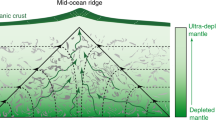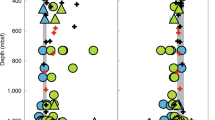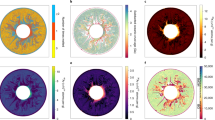Abstract
High 3He/4He ratios sampled at many ocean islands are usually attributed to an essentially undegassed lower-mantle reservoir with high 3He concentrations1,2,3,4. A large and mostly undegassed mantle reservoir is also required to balance the Earth’s 40Ar budget, because only half of the 40Ar produced from the radioactive decay of 40K is accounted for by the atmosphere and upper mantle5. However, geophysical6,7 and geochemical observations8 suggest slab subduction into the lower mantle, implying that most or all of Earth’s mantle should have been processed by partial melting beneath mid-ocean ridges and hotspot volcanoes. This should have left noble gases in both the upper and the lower mantle extensively outgassed, contrary to expectations from 3He/4He ratios and the Earth’s 40Ar budget. Here we suggest a simple solution: recycling and mixing of noble-gas-depleted slabs dilutes the concentrations of noble gases in the mantle, thereby decreasing the rate of mantle degassing and leaving significant amounts of noble gases in the processed mantle. As a result, even when the mass flux across the 660-km seismic discontinuity is equivalent to approximately one lower-mantle mass over the Earth’s history, high 3He contents, high 3He/4He ratios and 40Ar concentrations high enough to satisfy the 40Ar mass balance of the Earth can be preserved in the lower mantle. The differences in 3He/4He ratios between mid-ocean-ridge basalts and ocean island basalts, as well as high concentrations of 3He and 40Ar in the mantle source of ocean island basalts4, can be explained within the framework of different processing rates for the upper and the lower mantle. Hence, to preserve primitive noble gas signatures, we find no need for hidden reservoirs or convective isolation of the lower mantle for any length of time.
This is a preview of subscription content, access via your institution
Access options
Subscribe to this journal
Receive 51 print issues and online access
$199.00 per year
only $3.90 per issue
Buy this article
- Purchase on Springer Link
- Instant access to full article PDF
Prices may be subject to local taxes which are calculated during checkout




Similar content being viewed by others
References
Kurz, M. D., Jenkins, W. J. & Hart, S. R. Helium isotopic systematics of oceanic islands and mantle heterogeneity. Nature 297, 43–47 (1982)
Allègre, C. J., Staudacher, T. & Sarda, P. Rare-gas systematics: formation of the atmosphere, evolution and structure of the Earth’s mantle. Earth Planet. Sci. Lett. 81, 127–150 (1987)
Harper, C. L. & Jacobsen, S. B. Noble gases and Earth’s accretion. Science 273, 1814–1818 (1996)
Gonnermann, H. M. & Mukhopadhyay, S. Non-equilibrium degassing and a primordial source for helium in ocean-island volcanism. Nature 449, 1037–1040 (2007)
Allègre, C. J., Hofmann, A. & O’Nions, K. The argon constraints on mantle structure. Geophys. Res. Lett. 23, 3555–3557 (1996)
Grand, S. P., van der Hilst, R. D. & Widiyantoro, S. Global seismic tomography: a snapshot of convection in the Earth. GSA Today 7, 1–7 (1997)
van der Hilst, R. D., Widiyantoro, S. & Engdahl, E. R. Evidence for deep mantle circulation from global tomography. Nature 386, 578–584 (1997)
Hofmann, A. W., Jochum, K. P., Seufert, M. & White, W. M. Nb and Pb in oceanic basalts - new constraints on mantle evolution. Earth Planet. Sci. Lett. 79, 33–45 (1986)
O’Nions, R. K. & Tolstikhin, I. N. Limits on the mass flux between lower and upper mantle and stability of layering. Earth Planet. Sci. Lett. 139, 213–222 (1996)
Albarède, F. Time-dependent models of U-Th-He and K-Ar evolution and the layering of mantle convection. Chem. Geol. 145, 413–429 (1998)
Parman, S. W. Helium isotopic evidence for episodic mantle melting and crustal growth. Nature 446, 900–903 (2007)
Heber, V. S., Brooker, R. A., Kelley, S. P. & wood, B. J. Crystal-melt partitioning of noble gases (helium, neon, argon, krypton, and xenon) for olivine and clinopyroxene. Geochim. Cosmochim. Acta 71, 1041–1061 (2007)
Class, C. & Goldstein, S. L. Evolution of helium isotopes in the Earth’s mantle. Nature 436, 1107–1112 (2005)
Staudacher, T. & Allègre, C. J. Recycling of oceanic-crust and sediments—the noble-gas subduction barrier. Earth Planet. Sci. Lett. 89, 173–183 (1988)
Allègre, C. J. & Turcotte, D. L. Implications of a two-component marble-cake mantle. Nature 323, 123–127 (1986)
Coltice, N. & Schmalzl, J. Mixing times in the mantle of the early Earth derived from 2-D and 3-D numerical simulations of convection. Geophys. Res. Lett. 33 10.1029/2006GL027707 (2006)
Albarede, F. Rogue mantle helium and neon. Science 319, 943–945 (2008)
Hart, S. R., Hauri, E. H., Oschmann, L. A. & Whitehead, J. A. Mantle plumes and entrainment - isotopic evidence. Science 256, 517–520 (1992)
Jacobsen, S. B. & Wasserburg, G. J. Mean age of mantle and crustal reservoirs. J. Geophys. Res. 84, 7411–7427 (1979)
Albarède, F. Radiogenic ingrowth in systems with multiple reservoirs: applications to the differentiation of the mantle-crust system. Earth Planet. Sci. Lett. 189, 59–73 (2001)
Kellogg, J. B., Jacobsen, S. B. & O’Connell, R. J. Modeling the distribution of isotopic ratios in geochemical reservoirs. Earth Planet. Sci. Lett. 204, 183–202 (2002)
Fukao, Y., Widiyantoro, S. & Obayashi, M. Stagnant slabs in the upper and lower mantle transition region. Rev. Geophys. 39, 291–323 (2001)
Gu, Y. J., Dziewoński, A. M., Su, W. & Ekström, G. Models of the mantle shear velocity and discontinuities in the pattern of lateral heterogeneities. J. Geophys. Res. 106, 11169–11199 (2001)
Kustowski, B., Ekström, G. & Dziewoński, A. M. Anisotropic shear-wave velocity structure of the Earth’s mantle: a global model. J. Geophys. Res. 113 10.1029/2007JB005169 (2008)
O’Connell, R. J. & Hager, B. H. Ridge migration and mantle differentiation. Eos 61, 373 (1980)
Porcelli, D. & Elliott, T. The evolution of He isotopes in the convecting mantle and the preservation of high 3He/4He ratios. Earth Planet. Sci. Lett. 269, 175–185 (2008)
Kellogg, L. H. & Wasserburg, G. J. The role of plumes in mantle helium fluxes. Earth Planet. Sci. Lett. 99, 276–289 (1990)
Graham, D. W. in Noble Gases in Geochemistry and Cosmochemistry (eds Porcelli, D., Ballentine, C. & Wieler, R.) 247–317 (Rev. Mineral. Geochem. Vol. 47, Mineralogical Society of America, 2002)
Workman, R. K. & Hart, S. R. Major and trace element composition of the depleted MORB mantle (DMM). Earth Planet. Sci. Lett. 231, 53–72 (2005)
Boyet, M. & Carlson, R. W. A new geochemical model for the Earth’s mantle inferred from 146Sm–142Nd systematics. Earth Planet. Sci. Lett. 250, 254–268 (2006)
Farley, K. A., Maierreimer, E., Schlosser, P. & Broecker, W. S. Constraints on mantle 3He fluxes and deep-sea circulation from an oceanic general-circulation model. J. Geophys. Res. 100, 3829–3839 (1995)
Acknowledgements
We thank R. O’Connell, A. Dziewonski, C. Langmuir, E. Hellebrand for discussions and D. Graham for a thorough review of the manuscript. H.M.G. was in part supported by the University of Hawaii, SOEST Young Investigator programme. S.M. was in part supported by US National Science Foundation grant EAR 0509721.
Author Contributions H.M.G. and S.M. together developed the ideas presented here. H.M.G. developed the geochemical reservoir model and performed the numerical modelling. H.M.G. and S.M. analysed the results and co-wrote the paper.
Author information
Authors and Affiliations
Corresponding authors
Supplementary information
Supplementary Information
This file contains Supplementary Data, Supplementary Figures S1-S5 with Legends, Supplementary Table 1 and Supplementary References. (PDF 435 kb)
Rights and permissions
About this article
Cite this article
Gonnermann, H., Mukhopadhyay, S. Preserving noble gases in a convecting mantle. Nature 459, 560–563 (2009). https://doi.org/10.1038/nature08018
Received:
Accepted:
Issue Date:
DOI: https://doi.org/10.1038/nature08018
This article is cited by
-
Highest terrestrial 3He/4He credibly from the core
Nature (2023)
-
Earth’s mantle composition revealed by mantle plumes
Nature Reviews Earth & Environment (2023)
-
Earth’s missing argon paradox resolved by recycling of oceanic crust
Nature Geoscience (2022)
-
Geochemical evidence for high volatile fluxes from the mantle at the end of the Archaean
Nature (2019)
-
The origin and degassing history of the Earth's atmosphere revealed by Archean xenon
Nature Communications (2017)
Comments
By submitting a comment you agree to abide by our Terms and Community Guidelines. If you find something abusive or that does not comply with our terms or guidelines please flag it as inappropriate.



